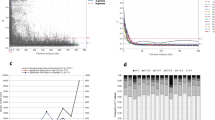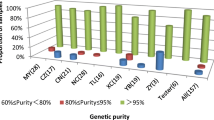Abstract
Information about the extent and genomic distribution of linkage disequilibrium (LD) is of fundamental importance for association mapping. The main objectives of this study were to (1) investigate genetic diversity within germplasm groups of elite European maize (Zea mays L.) inbred lines, (2) examine the population structure of elite European maize germplasm, and (3) determine the extent and genomic distribution of LD between pairs of simple sequence repeat (SSR) markers. We examined genetic diversity and LD in a cross section of European and US elite breeding material comprising 147 inbred lines genotyped with 100 SSR markers. For gene diversity within each group, significant (P<0.05) differences existed among the groups. The LD was significant (P<0.05) for 49% of the SSR marker pairs in the 80 flint lines and for 56% of the SSR marker pairs in the 57 dent lines. The ratio of linked to unlinked loci in LD was 1.1 for both germplasm groups. The high incidence of LD suggests that the extent of LD between SSR markers should allow the detection of marker-phenotype associations in a genome scan. However, our results also indicate that a high proportion of the observed LD is generated by forces, such as relatedness, population stratification, and genetic drift, which cause a high risk of detecting false positives in association mapping.



Similar content being viewed by others
References
Alpert KB, Tanksley SD (1996) High-resolution mapping and isolation of a yeast artificial chromosome contig containing fw2.2: A major fruit weight quantitative trait locus in tomato. Proc Natl Acad Sci USA 93:15503–15507
Bernardo R (2002) Breeding for quantitative traits in plants. Stemma Press, Woodbury, p24
Brandolini AG (1969) European races of maize. Proc Annu Corn Sorghum Res Conf 24:36–48
Ching A, Caldwell KS, Jung M, Dolan M, Smith OSH, Tingey S, Morgante M, Rafalski AJ (2002) SNP frequency, haplotype structure and linkage disequilibrium in elite maize inbred lines. BMC Genet 3:1–14
Corder EH, Saunders AM, Risch NJ, Strittmatter WJ, Schmechel DE, Gaskell PC, Rimmler JB, Locke PA, Conneally PM, Schmader KE, Small GW, Roses AD, Haines JL, Pericak-Vance MA (1994) Protective effect of apolipoprotein E type 2 allele for late onset Alzheimer disease. Nat Genet 7:180–184
Flint-Garcia SA, Thornsberry JM, Buckler ES (2003) Structure of linkage disequilibrium in plants. Annu Rev Plant Biol 54:357–374
Gower JC (1966) Some distance properties of latent root and vector methods used in multivariate analysis. Biometrika 53:325–338
Haldane JBS, Waddington CH (1931) Inbreeding and linkage. Genetics 16:357–374
Hill WG, Robertson A (1968) Linkage disequilibrium in finite populations. Theor Appl Genet 38:226–231
Huttley GA, Smith MW, Carrington M, O’Brien SJ (1999) A scan for linkage disequilibrium across the human genome. Genetics 152:1711–1722
Ihaka R, Gentleman R (1996) A language for data analysis and graphics. J Comput Graph Stat 3:299–314
Jannoo N, Grivet L, Dookun A, D’Hont A, Glaszmann JC (1999) Linkage disequilibrium among modern sugarcane cultivars. Theor Appl Genet 99:1053–1060
Kerem B, Rommens JM, Buchanan JA, Markievicz D, Cox DK, Chakravarti A, Buchwald M, Tsui LC (1989) Identification of the cystic fibrosis gene: genetic analysis. Science 245:1073–1080
Kraakman ATW, Niks RE, Van den Berg PMMM, Stam P, Van Eeuwijk FA (2004) Linkage disequilibrium mapping of yield and yield stability in modern spring barley cultivars. Genetics 168:435–446
Lewis PO, Zaykin D (2002) GDA manual. University of North Carolina Press, Chapel Hill
Liu J (2002) powermarker—A powerful software for marker data analysis. North Carolina State University Bioinformatics Research Center, Raleigh, N.C.
Liu K, Goodman M, Muse S, Smith JS, Buckler E, Doebley J (2003) Genetic structure and diversity among maize inbred lines as inferred from DNA microsatellites. Genetics 165:2117–2128
Lübberstedt T, Melchinger AE, Dußle C, Vuylsteke M, Kuiper M (2000) Relationships among early European maize Inbreds: IV. Genetic diversity revealed with AFLP Markers and comparison with RFLP, RAPD, and pedigree data. Crop Sci 40:783–791
Maurer HP, Melchinger AE, Frisch M (2004) PLABSOFT: Software for simulation and data analysis in plant breeding. In: 17th EUCARPIA Gen Congr 2004 (poster abstr). Tulln, Austria
Messmer MM, Melchinger AE, Boppenmaier J, Brunklaus-Jung E, Herrmann RG (1992) Relationships among early European maize inbreds: I. Genetic diversity among flint and dent lines revealed by RFLPs. Crop Sci 32:1301–1309
Nei M (1987) Molecular evolutionary genetics. Columbia University Press, New York
Nordborg M, Borevitz JO, Bergelson J, Berry CC, Chory J, Hagenblad J, Kreitman M, Maloof JN, Noyes T, Oefner PJ, Stahl EA, Weigel D (2002) The extent of linkage disequilibrium in Arabidopsis thaliana. Nat Genet 30:190–193
Parisseaux B, Bernardo R (2004) In silico mapping of quantitative trait loci in maize. Theor Appl Genet 109:508–514
Pritchard JK, Wen W (2004) Documentation for STRUCTURE software. The University of Chicago Press, Chicago
Pritchard JK, Stephens M, Donelly P (2000) Inference of population structure using multilocus genotype data. Genetics 155:945–959
Rebourg C, Chastanet M, Gouesnard B, Welcker C, Dubreuil P, Charcosset A (2003) Maize introduction into Europe: the history reviewed in the light of molecular data. Theor Appl Genet 106:895–903
Reif JC, Hamrit S, Heckenberger M, Schipprack W, Maurer HP, Bohn M, Melchinger AE (2005) Genetic structure and diversity of European flint maize populations determined with SSR analyses of individuals and bulks. Theor Appl Genet (in press)
Remington DL, Thornsberry JM, Matsuoka Y, Wilson LM, Whitt SR, Doebley J, Kresovich S, Goodman MM, Buckler ES (2001) Structure of linkage disequilibrium and phenotypic associations in the maize genome. Proc Natl Acad Sci USA 98:11479–11484
Robinson HF, Cockerham CC, Moll RH (1960) Studies on estimation of dominance variance and effects of linkage bias. In: Kempthorne O (ed) Biometrical genetics. Pergamon Press, New York, pp 171–177
Schnell FW (1992) Maiszüchtung und die Züchtungsforschung in der Bundesrepublik Deutschland. Vortr Pflanzenzücht 22:27–44
Service SK, Ophoff RA, Freimer NB (2001) The genome-wide distribution of background linkage disequilibrium in a population isolate. Hum Mol Genet 10:545–551
Stahel WA (1995) Statistische Datenanalyse. Friedrich Vieweg & Sohn Verlagsgesellschaft, Braunschweig, p 245
Stuber CW, Polacco M, Senior ML (1999) Synergy of empirical breeding, marker-assisted selection, and genomics to increase crop yield potential. Crop Sci 39:1571–1583
Tenaillon MI, Sawkins MC, Long AD, Gaut RL, Doebley JF, Gaut BS (2001) Patterns of DNA sequence polymorphism along chromosome 1 of maize (Zea mays ssp. mays L.). Proc Natl Acad Sci USA 98:9161–9166
Tenesa A, Knott SA, Ward D, Smith D, Williams JL, Visscher PM (2003) Estimation of linkage disequilibrium in a sample of the United Kingdom dairy cattle population using unphased genotypes. J Anim Sci 81:617–623
Vigouroux Y, Jaqueth JS, Matsuoka Y, Smith OS, Beavis WD, Smith JS, Doebley J (2002) Rate and pattern of mutation at microsatellite loci in maize. Mol Biol Evol 19:1251–1260
Weir BS (1996) Genetic data analysis II, 2nd edn. Sinauer, Sunderland, p 127
Wright S (1978) Evolution and genetics of populations, vol IV. The University of Chicago Press, Chicago, p 91
Acknowledgements
The molecular marker analysis of this research was supported by funds from the “Gemeinschaft zur Förderung der privaten deutschen Pflanzenzüchtung” (GFP), Germany. Financial support for B. Stich was provided by a grant from the German National Academic Foundation. The authors thank the associate editor and two anonymous reviewers for their valuable suggestions.
Author information
Authors and Affiliations
Corresponding author
Additional information
Communicated by R. Bernardo
Rights and permissions
About this article
Cite this article
Stich, B., Melchinger, A.E., Frisch, M. et al. Linkage disequilibrium in European elite maize germplasm investigated with SSRs. Theor Appl Genet 111, 723–730 (2005). https://doi.org/10.1007/s00122-005-2057-x
Received:
Accepted:
Published:
Issue Date:
DOI: https://doi.org/10.1007/s00122-005-2057-x




